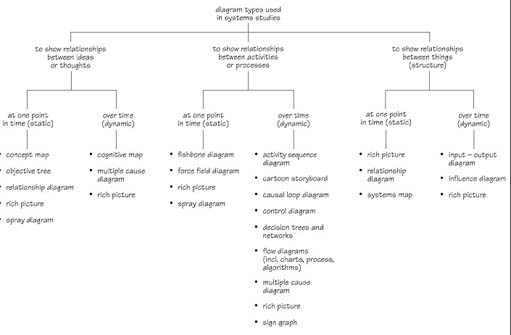2.3 Structure and process
Diagrams are normally intended to describe either structure or process and not both. Table 1 gives a classification of diagram types by structure or process. Another way to view this is to note that there are diagram types that represent largely static relationships and those that represent situations over a period of time. Though some, like the influence diagram, may appear to contain both structure and process, the emphasis is on the static relationships, not the temporal processes, in the situation.
| Structure | Process |
|---|---|
| Spray diagram | Multiple cause diagram |
| Relationship diagram | Input-output |
| Systems map | Flow-block |
| Influence diagram | Flow-process |
| Rich picture | Rich picture |
| Force-field diagram | Conceptual model |
| Causal loop | |
| Activity sequence | |
| Decision trees | |
| Control model |
Another classification of diagram types is shown as Figure 2. This orders diagrams by the two main features introduced above: namely, whether they emphasise thoughts, things or processes and whether they show static or dynamic relationships. This does distinguish between many of the diagram types, but some are found in more than one category. However this is not the only way to group diagram types as you will see later in Section 4. It is also my view on how to group them. You may have other ideas when you have finished reading the course!

This brief outline of the types of diagrams you will meet gives you some idea of their main features, but how and when do you use them? We will be looking at both these questions in this course, although the emphasis will be on the non-pictorial schematic and conceptual diagrams. Before we do so I want to re-emphasise that whenever we take in, think and express new ideas, we describe and represent the ‘reality’ we perceive (in words, lines, pictures, symbols or numbers) by making simplifications for some purpose. This has to be the case, because reality is so complicated. It is essential to simplify ‘the real world’, in order to be able to describe it, or think about it. In simplifying, we select certain features of a situation – the essentials – to communicate a clear message, without too much clutter obscuring the view. The view, or perspective, taken and the choice of features is extremely important in conveying that message (or the message that we convey!).
